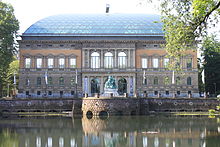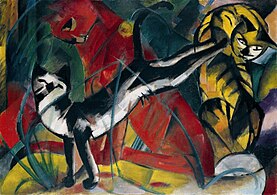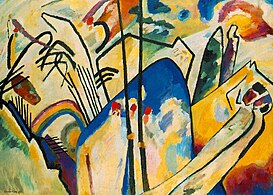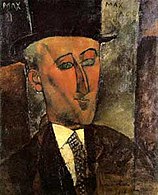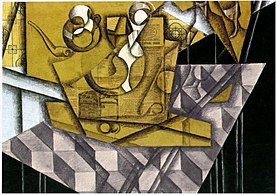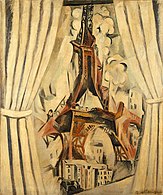Art collection of North Rhine-Westphalia
The Kunstsammlung Nordrhein-Westfalen is the art collection of the state of North Rhine-Westphalia in the state capital Düsseldorf . It unites three exhibition locations : the K20 at Grabbeplatz 5 ⊙ , the K21 in the Ständehaus at Ständehausstrasse 1 ⊙ and the Schmela-Haus at Mutter-Ey-Strasse 3 ⊙ . The art collection was founded in 1961 by the state government as a foundation under private law for the purpose of public collection and exhibition of art collections. Since the collection of the Gemäldegalerie Düsseldorf was removed in 1805, the city has again had an important state art collection. Behind its foundation was the identity-political endeavor of the state government led by Franz Meyers to give North Rhine-Westphalia a stronger cultural-political profile and thereby raise the residents' state and spatial awareness for the young and heterogeneous country .
In its more than 50-year history, the North Rhine-Westphalia Art Collection has gained an international profile as a museum for 20th century art . But the spectrum of the state-owned gallery, which emerged from a purchase of works by Paul Klee , has long since extended to the present day. The building on Grabbeplatz (K20) with its characteristic black granite facade celebrated its opening in 1986. An extension was completed in 2010.
With important works by, among others, Pablo Picasso , Henri Matisse and Piet Mondrian, as well as the extensive collection of around 100 drawings and paintings by Paul Klee, the permanent collection of the art collection offers a unique look at classical modernism . Works by Jackson Pollock , Frank Stella or Pop Art by Robert Rauschenberg , Jasper Johns or Andy Warhol are part of the inventory of American post-war art; works by Joseph Beuys , Gerhard Richter , Tony Cragg , Sarah Morris , Katharina Fritsch and Imi Knoebel also shape the collection.
As a further location for the art collection, the Ständehaus on Kaiserteich , formerly the seat of the North Rhine-Westphalian state parliament , was opened in spring 2002 (K21) . Among other things, artist rooms and room installations can be seen, which represent a focus of the collection.
The Schmela-Haus, located in Düsseldorf's old town , has enriched the state collection as a “rehearsal stage” and lecture venue since 2009. The listed building by the Dutch architect Aldo van Eyck (1918–1999) housed the Alfred Schmela Gallery when it opened in 1971 , the first gallery building in the Federal Republic of Germany built specifically for this purpose. Since spring 2011 the Schmela-Haus has been used again for exhibitions.
As a house in three locations, the state's art collection has a total of more than 10,000 square meters of exhibition space.
With accompanying programs and special projects, the Education Department makes the art collection of the state collection accessible to visitors of all ages. Several studios, a media workshop and the “laboratory” integrated into the exhibition rooms are available for this purpose.
history
The history of the Kunstsammlung Nordrhein-Westfalen began in 1960 with the purchase of 88 works by Paul Klee from the possession of the Pittsburgh- based steel industrialist G. David Thompson (1899–1965). The acquisition, which was brokered by the Basel gallery owner Ernst Beyeler and made by the then Prime Minister Franz Meyers , forms the basis of the collection, which was founded in 1961 under the name Stiftung Kunstsammlung Nordrhein-Westfalen. From 1962 until his retirement in 1990, Werner Schmalenbach was the first director of the newly founded collection. He built up an extremely high-quality collection of Classical Modernism and thus created the only state collection in Germany specializing in modern art, “first crowning highlight” and “a stroke of luck in the cultural history of the post-war period”.
The collection was initially housed in Jägerhof Palace. However, the limited space soon after the opening led to the planning of a new building on the site of the former Kunstgewerbemuseum Düsseldorf and the Alte Kunsthalle, which was demolished in the post-war period . In 1975, for example, a construction competition was announced, from which the Danish architecture firm Dissing + Weitling emerged as the winner. The building, which in terms of architectural history can be placed in the context of a transition from post-war modernism to post-modernism , was opened on March 14, 1986 in the presence of Federal President Richard von Weizsäcker and has been one of the city's landmarks ever since. The building with a curved facade made of polished black natural stone characterizes the grave site. It is directly opposite the Kunsthalle Düsseldorf , whose building also serves as the seat of the art association for the Rhineland and Westphalia .
In 1990, the then acting director Werner Schmalenbach was replaced as director by Armin Second , previously director of the municipal gallery in Munich's Lenbachhaus . While Schmalenbach expanded the exhibition mainly to include masterpieces of painting , since 1990 his successor has mainly included sculptures , installations and photographs of international standing. From September 1, 2009 to October 31, 2016, Marion Ackermann , the previous director of the Kunstmuseum Stuttgart , took over the artistic direction of the Kunstsammlung Nordrhein-Westfalen. Her goal was to deal with the collection more dynamically and to relate contemporary art and classical modern art more closely to one another. From November 2009 to August 2016, she also formed the foundation's board of directors together with the commercial director, Hagen Lippe-Weißenfeld. Hagen Lippe-Weißenfeld left the North Rhine-Westphalia art collection on August 31, 2016. Marion Ackermann took up her post as General Director of the Dresden State Art Collections on November 1st, 2016 . In Düsseldorf she is succeeded by Susanne Gaensheimer , who became director of the North Rhine-Westphalia Art Collection on September 1, 2017.
On November 12, 2009, the art collection opened the former exhibition rooms of the Schmela Gallery in Düsseldorf's old town, Mutter-Ey-Straße 3, where exhibitions, discussions and other activities are held.
After more than two years of closure due to extensive renovations and the expansion of the house with a new building, the K20 on Grabbeplatz was able to resume exhibition operations in July 2010. An adequate area is now available for the collection and temporary exhibitions. The Belgian Kris Martin and the German Michael Sailstorfer were the first to create accessible room installations for the two halls of the new building, which total almost 2,000 square meters, the Klee Hall and the Konrad and Gabriele Henkel Gallery.
Already in the first two weeks after the reopening, almost 60,000 guests came to the art collection with free entry. The 100,000. Visitor was welcomed on October 21, 2010. The “Hornet” wall mosaic created by the American artist Sarah Morris from brightly colored surfaces is part of the concept of a stronger public image for the art collection, which can now show the state's art possessions more comprehensively than ever before . At 27 meters in length, it has become an attraction on the newly created Paul-Klee-Platz at the back of the K20 .
Hornet by Sarah Morris , 2010, Paul-Klee-Platz at K20 Grabbeplatz
Your natural yellow daylight by Olafur Eliasson , 2010, K20 Grabbeplatz
In addition to permanent collection presentations, there are also internationally acclaimed temporary exhibitions in the buildings of the North Rhine-Westphalia Art Collection. From September 11, 2010 to January 16, 2011, an extensive Joseph Beuys exhibition entitled “Parallel Processes” took place in the K20 and Schmela-Haus , with the focus on large installations from all of the artist's creative periods. The exhibition took place as the first special exhibition after the reopening of the art collection on Grabbeplatz in the program of the Düsseldorf Quadriennale and was seen by 103,000 visitors.
management
- Werner Schmalenbach (1962–1990)
- Armin Second (1990-2007)
- Marion Ackermann (2009-2016)
- Susanne Gaensheimer (since September 1, 2017)
architecture
K20 at Grabbeplatz
The construction of the art collection K20 at Grabbeplatz 5 with a characteristic facade made of black Bornholm granite was opened in 1986. In the tradition of the architect Arne Jacobsen , the Copenhagen architecture firm Dissing + Weitling realized a building with details typical of the time, which emphasized the quality of the works of art.
The Grabbe Hall, the highest exhibition room in the building with a ceiling height of 14 meters, opens at ground level from the entrance foyer. The 600 m² column-free hall is used for temporary exhibitions.
Three single-flight staircases arranged one behind the other open up the two upper floors from the foyer. The large hall on the first floor, like the collection rooms on the second floor, has a skylight .
In 2008, the foundation stone for the extension was laid, which opened in July 2010. The building, which was realized by the same architects' office, ties in with the old building in terms of its architectural design. During the two-year closure phase of the museum, the existing building was also completely renovated and adapted to the current technical standard.
An additional 2,000 m² are available in two pillar-free exhibition halls in the extension. The Klee Hall is on the right side of the foyer of the old building and is mainly used for temporary exhibitions. The clear height of the room is 6.40 m, the hall is artificially illuminated with over 500 spotlights. A narrow staircase in the rear connects the ground floor with the new upper hall. The total exhibition area of the art collection on Grabbeplatz is now more than 5,000 m².
Paul-Klee-Platz behind the entrance to the K20 art collection was redesigned after the museum opened in 2012. White benches surround a small grove of white Himalayan birch trees and markings on the ground show the course of the former city wall, the remains of which have been found here. An original fragment of the city wall from 1384 is exhibited in a showcase, an information board in the pavement gives the relevant explanations.
K21 in the Ständehaus
The museum in the Ständehaus am Kaiserteich, Ständehausstrasse 1, was opened as the second mainstay of the art collection for modern art on April 18, 2002 under the name K21 by the then Federal President Johannes Rau .
The Düsseldorfer Ständehaus was built from 1876–1880 by the architect Julius Raschdorff in the style of the historical neo-renaissance. The Ständehaus, founded in 1880, housed the provincial assembly of the Prussian Rhine Province for many years . The state parliament of North Rhine-Westphalia met here from 1949 to 1988. After the state parliament had moved, the state house stood empty for 14 years.
Four wings of the building with circumferential arcades surround the central public square of the house, a spacious piazza. The three-year renovation work on the representative building in the historicist style was planned by the architects Kiessler + Partner from Munich . They created a modern museum building with an impressive glass domed roof in the form of a hollow vault made of 1919 panes, which determines the aesthetics of the building.
While the outer facade was retained, almost all fixtures inside were removed. The historic staircase has been preserved and leads to the galleries on the three upper floors. The flexible exhibition hall in the basement and the upper rooms have over 5,300 m² of exhibition space.
Barnett Newman : Zim Zum II
Schmela House
Today's Schmela-Haus at Mutter-Ey-Strasse 3 was designed by the Dutch architect Aldo van Eyck (1918–1999), one of the main exponents of structuralist architecture . When it opened in 1971, the building, which is now a listed building under the name Galerie Schmela, was the first specially constructed gallery building in the Federal Republic of Germany. The five-storey house made of gray pumice concrete shows an interplay of inside and outside, of private living and “public” exhibition spaces. After the gallery moved out, the building was acquired by the state of North Rhine-Westphalia in 2008 and has been used as an exhibition space by the art collection since 2009. From summer 2020 the gallery owners Hans Mayer and his son Max Mayer will move in to sublet.
collection


The collection includes a unique selection of works from the 20th and 21st centuries. The highlights include pictures of German Expressionism , important paintings by Pablo Picasso , Wassily Kandinsky , Jackson Pollock and Piet Mondrian, and installations by Joseph Beuys and Nam June Paik . In addition to these works, which have long since become icons of art, there are other outstanding examples from Classical Modernism, American art after 1945, important room installations, photographs, and film and video works by contemporary artists. Critics refer to the collection, which has a remarkable quality of individual works, as the "secret National Gallery".
Franz Marc : Three cats , around 1913
The focus of the collection is on classical modernism. The works of art before 1945 range from Fauvism , Expressionism , Pittura Metafisica and Cubism to works by the artist group “ Der Blaue Reiter ” as well as Dadaism and Surrealism . The collection of Paul Klee's work now includes almost 100 works. The 88 paintings, drawings and colored works on paper, which formed the basis of the North Rhine-Westphalia art collection, were acquired by the state of North Rhine-Westphalia in 1960 for 6 million DM. This sum appeared high at the time, but must be viewed as low today. The works originally belonged to a private collector from Pittsburgh, USA .
The groups of works by individual artists include twelve works by Pablo Picasso , which encompass almost all of the artist's important creative phases. The thematic focuses of Cubism in the art collection include works by Pablo Picasso, Fernand Léger , Juan Gris and Georges Braque, among others .
Amedeo Modigliani : Portrait Max Jacob , 1916
Piet Mondrian : New York City I , 1941
Juan Gris : Tea Cups , 1914
Robert Delaunay : View of the Eiffel Tower , 1910
August Macke : Freiburg Cathedral , 1914
The art after 1945 is mainly presented through around 40 exhibits of American art. Works by Mark Rothko , Robert Rauschenberg , Andy Warhol , Donald Judd and Jackson Pollock should be mentioned. Pollock's monumental work Number 32 from 1950 is one of the artist's few wall-filling “drip paintings” and one of the most important examples of abstract expressionist painting. Among the four works by Robert Rauschenberg is Wager from 1957 , one of the largest and most complex of his "Combine Paintings" .
Post-war European art is represented by Markus Lüpertz , Per Kirkeby , Gerhard Richter and Joseph Beuys , whose late work “ Palazzo Regale ”, which was acquired in 1992, is supplemented by another 60 works. They come from the former private collection of Günter Ulbricht from Düsseldorf .
Room installations and artist spaces are among the focal points of the art collection, which has been continuously expanded for several years (e.g. by the artist Marcel Broodthaers). German photography is represented in the collection by Bernd and Hilla Becher and other representatives of the Düsseldorf School of Photography . In the area of new media, film and video works, the collection is still under construction, so far it comprises around 90 exhibits.
In 2005, the private collection of Simone and Heinz Ackermans with 150 works of international contemporary art was acquired by the state of North Rhine-Westphalia, after selected works had already been shown at K21 from 2002 to 2005 . The focus of the Ackermans collection is on art since the 1980s, on figurative sculptures, photographic works, installations as well as film and video works. The K21 artist rooms show continuously changing presentations by international contemporary artists such as Tomás Saraceno , Pamela Rosenkranz or Ulla von Brandenburg .
circle of friends
The Society of Friends of the Kunstsammlung Nordrhein-Westfalen eV has been accompanying the art collection since 1968. The association's tasks are described in the statutes: the non-material and material support of the Kunstsammlung Nordrhein-Westfalen. The focus is on the acquisition of works of art. Thanks to the Friends of the Art Collection, many otherwise unattainable wishes of the Art Collection have been fulfilled over the years.
In order to be able to meet the requirements, which have now grown significantly with three buildings - K20 , K21 and Schmela-Haus - the Friends' Association needs a steadily growing number of "friends" who are willing to both this internationally renowned museum of modern and contemporary art to promote ideally as well as materially.
Library
The K20 has a publicly accessible special library with literature on the art of the 20th and 21st centuries. The inventory comprises over 100,000 volumes that can be viewed on site. These include monographs , reference works, exhibition catalogs, magazines, bulletins and audiovisual media such as videos and CDs. After the death of the founding director, the library was renamed the Werner Schmalenbach Library.
Publications
- Susanne Gaensheimer , Doris Krystof, Falk Wolf (eds.): Ai Weiwei . Art Collection North Rhine-Westphalia and Prestel, Düsseldorf and Munich 2019, ISBN 978-3-7913-5905-2 . (German book trade edition and catalog for the exhibition in the Kunstsammlung Nordrhein-Westfalen, Düsseldorf, May 18 to September 1, 2019)
literature
- Kunstsammlung Nordrhein-Westfalen, Düsseldorf (ed.): Insights. The 20th century in the North Rhine-Westphalia Art Collection, Düsseldorf. Hatje Cantz Verlag, Ostfildern-Ruit 2000, ISBN 3-7757-0853-7 .
- Kunstsammlung Nordrhein-Westfalen, Düsseldorf and Prestel Verlag, Munich, Berlin, London, New York (ed.): Kunstsammlung Nordrhein-Westfalen. Prestel Verlag, Munich, 2003, ISBN 978-3-7913-5078-3 .
- Kunstsammlung Nordrhein-Westfalen, Düsseldorf (ed.): Masterpieces of the 20th and 21st centuries. Schirmer / Mosel 2010, ISBN 978-3-941773-01-1 .
Movies
- Art collection of North Rhine-Westphalia. Documentary, Germany, 2011, 29:30 min., Script and director: Martina Klug, production: SWR , 3sat , first broadcast: February 13, 2011, series: Museums-Check with Markus Brock , summary ( memento from January 9, 2017 in Internet Archive ) from 3sat, with Katharina Franck and Marion Ackermann .
Web links
- www.kunstsammlung.de Official website
- www.number32.de Online magazine of the North Rhine-Westphalia Art Collection
- Image film of the Kunstsammlung Nordrhein-Westfalen (2015, video on YouTube channel , 5:12 min)
- Photos from the K21
- Collection online
- Video: crash course in art history , WDR , August 3, 2011, about the history and the program of the art collection North Rhine-Westphalia in the program local time from Düsseldorf , 03:51 min.
Individual evidence
- ↑ Karl Ditt : The development of spatial awareness in Rhineland and Westphalia, in the Ruhr area and in North Rhine-Westphalia in the 19th and 20th centuries: characteristics and competitions . In: Karl Ditt, Klaus Tenfelde (eds.): The Ruhr area in Rhineland and Westphalia. Coexistence and Competition of Space Consciousness in the 19th and 20th Centuries . In: Research on regional history, Volume 57, Verlag Ferdinand Schöningh, Paderborn 2007, ISBN 978-3-506-75748-7 , p. 462.
- ^ Eduard Beaucamp : On the death of Werner Schmalenbach - Grand Seigneur of Art. In: FAZ of July 7, 2010.
- ↑ Kunstsammlung NRW rents Schmela Haus to Galleries , Welt , from November 12, 2019
- ↑ Ingeborg Wiensowski: The Secret National Gallery , Spiegel online from July 6, 2010, with photos.

